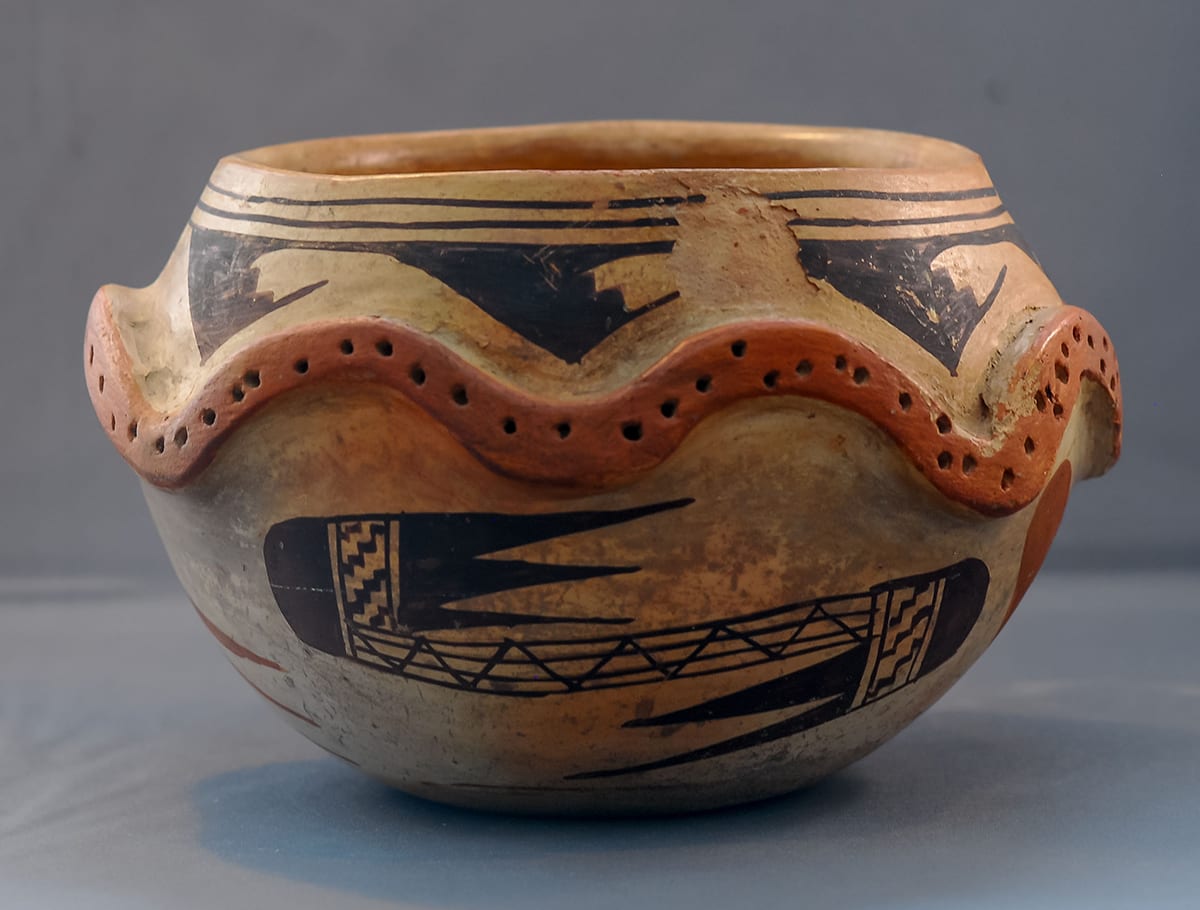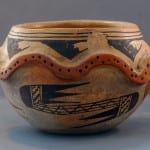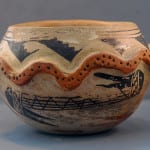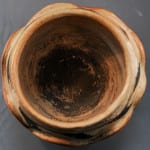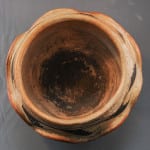This is not a particularly attractive pot, but it is a rare example of an innovative form, probably by Annie Healing.
Although the walls of this pot are even and reasonably thin, the pot is heavy for its size because of the added appliqué coil of clay with eight casual curves, seven of which are fairly flat and one which is narrower and thicker. I suspect that the maker ran out of space as she applied this coil and that this truncated curve marks spot where the ends of the coil were joined together. The pot seems to have been slipped with thin, light-colored clay that lightly crackled, much of which has eroded. The inside bottom of the jar is stained dark from use and the exterior near the lip is exfoliated. All this suggests that jar 2013-18 was once used to hold a flowerpot and was damaged by water.
The design is repetitious and missing areas can easily be imagined. Three thin lines encircle the moth. These are not particularly well drawn as the space between them varies. Hanging from the lower line are eight V-shaped black elements incorporating two to four rain-cloud steps. The number of steps seems to have been dictated by the varying space left above an appliqué band that encircles the jar. Sekaquaptewa and Washburn interpret this stepped motif as “clouds building and moving along” (2010:173).
There are a number of Nampeyo/Annie jars with appliqué bands documented in the literature. Two such jars are shown in a well-known photograph by Summer W. Matteson, reproduced (among other places) in Ashton (1976:33), Kramer (1996:75), and in larger format by Wade and Cooke (2012:148). Kramer argues that this photograph might be from the mid to late 1890s. Wade reports the date of the photograph as 1900 (2012:164) while Ashton cites this photograph as 1901-1906.
The Matteson photograph shows Nampeyo and Annie sitting surrounded by their pottery, though of course the photographer did not determine which woman made which pot. Two tall unusually shaped vases are at the left and right edges of the photograph and both seem to have appliqué rims. The Cooke collection has a large jar with appliqué that Wade believes was made by Nampeyo (2012:164-167). The line-work on the Cooke jar is quite delicate and precise, and I believe that it might have been made by Annie rather than her more exuberant mother, though this is just speculation on my part. Finally, the Blairs (1999:XIII) offer a photograph of an appliqué jar belonging to The Museum of Church History and Art of the Church of Jesus Christ of Latter-day Saints that is attributed to Annie Healing. This jar was cited on the sales tag of 2013-18.
All of the published pots discussed above show undulating ribbons of appliqué, either in sections or on a continuous rope, as on jar 2013-18. The appliqué on all the published jars seem to have wide indentations as if impressed by a finger. In contrast, the appliqué on jar 2013-18 has been punctuated by a sharp object about 100 times, leaving single or double rows of small round holes in the clay. Like the jar cited by the Blairs, the appliqué on 2013-18 has been painted with yellow clay that turned a pale red when fired.
Below the appliqué band, there are two painted motifs and a smudge. The most elaborate of these designs is painted black and is a version of wing tip used in the Nampeyo family “migration” design (Kramer 1996:185, D). There are two renditions of this design on the pot. Two wing tips are painted on each rendition facing in opposite directions, one above and one below a connecting device. In one rendition, the left wing is above the connecting element; on the second rendition, the left wing is below. In both renditions, the right wing is on the opposite side of the connecting motif as the left wing. The wings are finished with a three-stepped rain cloud line with three lines per tip though one tip has four such lines.
Connecting the wings is a four-line band of “musical notation” first seen in this collection on Nampeyo’s Kayenta-style bowl (2012-02), which is perhaps a few years older than pot 2013-18. One version of the migration design is about 6.75” long and the second about an inch shorter, both rendered about parallel with the rim. Between these black designs, there are solid red versions of the wing tip heading like a red comet up towards the rim. Perhaps because one of the black designs is shorter than the other, a gap in design was created into which the painter added a third red “comet” near the base of the jar. Behind it is a small red smudge line done in the same red paint.
I find it difficult to judge the age of pot 2013-18. The Masterson photograph might be as early as 1895. Nampeyo and Annie’s most innovative work was done from about 1900 to 1910, just before and after Nampeyo was comodified with the opening of Hopi House in 1905 (Kramer 1996:168-171). Based on this information, I believe that pot 2013-18 was produced between 1895 and 1910 with some bias towards the earlier years given the visual evidence in the 1895-1906 Masterson photograph.
The following seven deviations all suggest that the finishing of this pot was quickly done and not carefully considered:
1) The top framing band
2) The curvature of the appliqué coil
3) The irregular placement of holes on the appliqué band
4) The differing length and orientation of the black migration elements
5) The differing number of finishing lines in the wing tips
6) The addition of a third red comet to fill in blank space
7) The red smudge
Speaking of Annie’s painting, Kramer writes:
“As her work matured, it had a more delicate, horizontal feeling to it, like slanted penmanship. She was the first to repeatedly paint migration designs, her signature dots identifiable at the end of the wingtips” (1996:162).
The lightness of the painting lines suggests to me that the maker was Annie. On the other hand, the casual painting and finishing of the jar belies Annie’s reputation as a careful painter and is more characteristic of her mother. (Though the casual—almost sloppy—painting on this jar exceeds Nampeyo’s usual impulsive style.) The stepped elements in the ends of the wings do not meet Kramer’s observation that Annie used dots, unlike her mother and other family members who used stepped lines, as on this pot.
On the one hand, on the other…
As is often the case, there is substantial ambiguity as to the maker and painter of pot 2013-18. It looks most like the Latter-day Saints’ pot published by the Blairs as by Annie, but these authors do not provide the evidence that supports the conclusion that Annie was the maker of this published pot nor do they offer a date of production. The painting on 2013-18 seems light, as might be expected of Annie, but the design seems quickly applied, as one would expect more of her mother, though Nampeyo was not this sloppy.
Pot 2013-18 was most likely made between 1895 and 1905. Born about 1883, Annie would have been about 12 to 22 years old during this period. Perhaps pot 2013-18 displays the talents of a young woman still developing her style and skills and experimenting with the use of appliqué. Given what I know now, I attribute the production of this pot to a young Annie. Other examples of Hopi appliqué jars and better documentation of such jars might someday provide the information for a more definitive attribution. For pots that I believe were made by Annie’s sisters when young, see 2010-20 (Nellie) and 2006-15 (Fannie).

